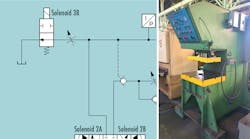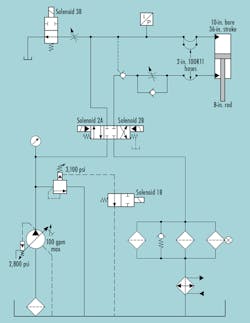A 100-ton press was designed and installed to close and form large pieces of ¼- to ½-in. thick sheet metal. To extend the press, solenoids 1B, 2A, and 3B (see accompanying schematic) would energize to extend the ram engage the metal while decompression valve 3B and solenoid 2A would de-energize. When pressure at the transducer dropped below 2,000 psi, solenoid 2B would energize to retract the ram.
The flow control was only used to create enough backpressure to keep the pilot-operated check valve open while the ram extended. The pressure-compensated pump had a displacement stroke adjustment to control the ram speed that was needed from time to time.
A problem with the rod-end hose blowing off started when the speed of the ram was reduced to process thinner plates. The hose would fail after several hundred plates were run.
Any idea what was causing the problem?
Solution to last month’s problem:
A problem occurred when a freshly filled mold for concrete blocks would open slightly, allowing concrete to leak from the bottom gap of the partially open mold. This happened after a dwell period and resulted in a rejected block because of the void created. An accumulator in the circuit is supposed to prevent momentary pressure dips when an actuator is energized. An accumulator works well if working cycles provide enough dwell time to keep it charged with oil.
In this case, though, the bladder in the accumulator had ruptured, which prevented it from storing pressurized fluid for each work cycle. Replacing the bladder solved the problem.
Congratulations to Bill O’Neill, hydraulic systems engineer at Caterpillar Inc., Peoria, Ill., for solving November’s Challenge and having his name drawn the those who responded correctly.
Bob Sheaf is the founder of CFC Industrial Training, Fairfield, Ohio. He and his company have been involved in troubleshooting, training, and consulting internationally for more than 30 years. For more information, call (513) 874-3225, or visit cfcindustrialtraining.com.



